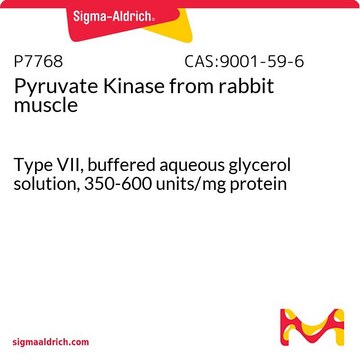P4390
Polynucleotide Kinase from T4-infected Escherichia coli
10 units/μL, buffered aqueous glycerol solution
Sign Into View Organizational & Contract Pricing
All Photos(1)
About This Item
CAS Number:
MDL number:
UNSPSC Code:
12352204
NACRES:
NA.53
Recommended Products
grade
for molecular biology
Quality Level
form
buffered aqueous glycerol solution
mol wt
33 kDa
concentration
10 units/μL
foreign activity
Endonuclease and exonuclease, none detected
shipped in
wet ice
storage temp.
−20°C
Looking for similar products? Visit Product Comparison Guide
Application
Suitable for:
- Sequencing or nucleic acid tagging (DNA and RNA) by 5′-end labeling
- 5′ phosphorylation of oligonucleotides
- Removal of 3′-phosphate groups from phosphorylpolynucleotides
Components
T4 Polynucleotide Kinase is supplied in a solution of 50% glycerol (v/v), 20 mM Tris-HCl (pH 7.5), 25 mM KCl, 2mM DTT, 0.1 mM EDTA, and 0.1 μM ATP.
Principle
Polynucleotide kinase catalyses a "forward reaction" transfer of the γ-phosphate of ATP to the 5′ hydroxyl terminus of single- and double-stranded nucleic acids (DNA and RNA) and 3′-nucleoside monophosphates. In exchange reactions containing ADP, the enzyme will catalyze the exchange of 5′-terminal phosphate groups and ATP. The 3′-phosphatase activity enables the enzyme to remove 3′-phosphoryl groups from phosphorylpolynucleotides.
1. Forward reaction: Transfer of the labeled γ-phosphate from [γ-32P]-ATP to the free 5′-hydroxyl group of the substrate.
5′-HO-DNA + [γ-32P]-ATP → 5′-32PO-DNA + ADP.
Substrates that do not have a free 5′-hydroxyl require prior dephosphorylation by alkaline phosphatase.
2. Exchange reaction: First, the terminal 5′-phosphate is transferred from the substrate to ADP present in the reaction mixture. Then, the labeled γ-phosphate from [γ-32P]-ATP is transferred to the free hydroxyl group of the substrate.
5′-PO-DNA + ADP → 5′-HO-DNA + ATP
5′-HO-DNA + [γ-32P]-ATP → 5′-32PO-DNA + ADP
1. Forward reaction: Transfer of the labeled γ-phosphate from [γ-32P]-ATP to the free 5′-hydroxyl group of the substrate.
5′-HO-DNA + [γ-32P]-ATP → 5′-32PO-DNA + ADP.
Substrates that do not have a free 5′-hydroxyl require prior dephosphorylation by alkaline phosphatase.
2. Exchange reaction: First, the terminal 5′-phosphate is transferred from the substrate to ADP present in the reaction mixture. Then, the labeled γ-phosphate from [γ-32P]-ATP is transferred to the free hydroxyl group of the substrate.
5′-PO-DNA + ADP → 5′-HO-DNA + ATP
5′-HO-DNA + [γ-32P]-ATP → 5′-32PO-DNA + ADP
Unit Definition
One unit catalyzes the transfer of one nanomole of 32P to the 5′-end of micrococcal nuclease-treated DNA in 30 min. at 37 °C. Transfer is detected as incorporation into acid-insoluble material.
Analysis Note
Activity is determined in a reaction mixture containing 40 mM Tris-HCl (pH 7.5), with 10 mM MgCl2, 5 mM dithiothreitol, 0.5 mM 5′-OH polynucleotide ends, and mM [γ-32P]-ATP.
related product
Product No.
Description
Pricing
Glutathione S-Transferase from E. coli, recombinant, expressed in E. coli, buffered aqueous solution
Ribonuclease A from bovine pancreas, for molecular biology, ≥70 Kunitz units/mg protein, lyophilized
Signal Word
Danger
Hazard Statements
Precautionary Statements
Hazard Classifications
Resp. Sens. 1
Storage Class Code
10 - Combustible liquids
WGK
WGK 3
Flash Point(F)
Not applicable
Flash Point(C)
Not applicable
Personal Protective Equipment
dust mask type N95 (US), Eyeshields, Gloves
Choose from one of the most recent versions:
Already Own This Product?
Find documentation for the products that you have recently purchased in the Document Library.
Priscilla Braglia et al.
EMBO reports, 11(10), 758-764 (2010-09-04)
Transcription termination by RNA polymerase I in Saccharomyces cerevisiae is mediated by a 'torpedo' mechanism: co-transcriptional RNA cleavage by Rnt1 at the ribosomal DNA 3'-region generates a 5'-end that is recognized by the 5'-3' exonuclease Rat1; this degrades the downstream
V Cameron et al.
Biochemistry, 16(23), 5120-5126 (1977-11-15)
The purification of T4 polynucleotide kinase results in the copurification of an activity which will specifically remove the 3'-terminal phosphate from a variety of deoxyribonucleotides and ribonucleotides in the absence of ATP. This phosphatase activity requires magnesium, has a pH
Saranya Siribal et al.
Molecular and biochemical parasitology, 180(1), 1-7 (2011-08-09)
Polynucleotide kinase/phosphatase (PNKP) is a bifunctional enzyme that can phosphorylate the 5'-OH termini and dephosphorylate the 3'-phosphate termini of DNA. It is a DNA repair enzyme involved in the processing of strand break termini, which permits subsequent repair proteins to
Takao Mori et al.
Molecular biology of the cell, 21(21), 3722-3734 (2010-09-17)
The unfolded protein response (UPR) is an essential signal transduction to cope with protein-folding stress in the endoplasmic reticulum. In the yeast UPR, the unconventional splicing of HAC1 mRNA is a key step. Translation of HAC1 pre-mRNA (HAC1(u) mRNA) is
Wenhe Wu et al.
Chemical communications (Cambridge, England), 47(4), 1201-1203 (2010-11-26)
We designed a single-fluorophore-tagged hairpin-structured nano-beacon probe by using a superquencher, graphene oxide (GO), based on which a new method for the analysis of DNA phosphorylation detection was developed.
Our team of scientists has experience in all areas of research including Life Science, Material Science, Chemical Synthesis, Chromatography, Analytical and many others.
Contact Technical Service







